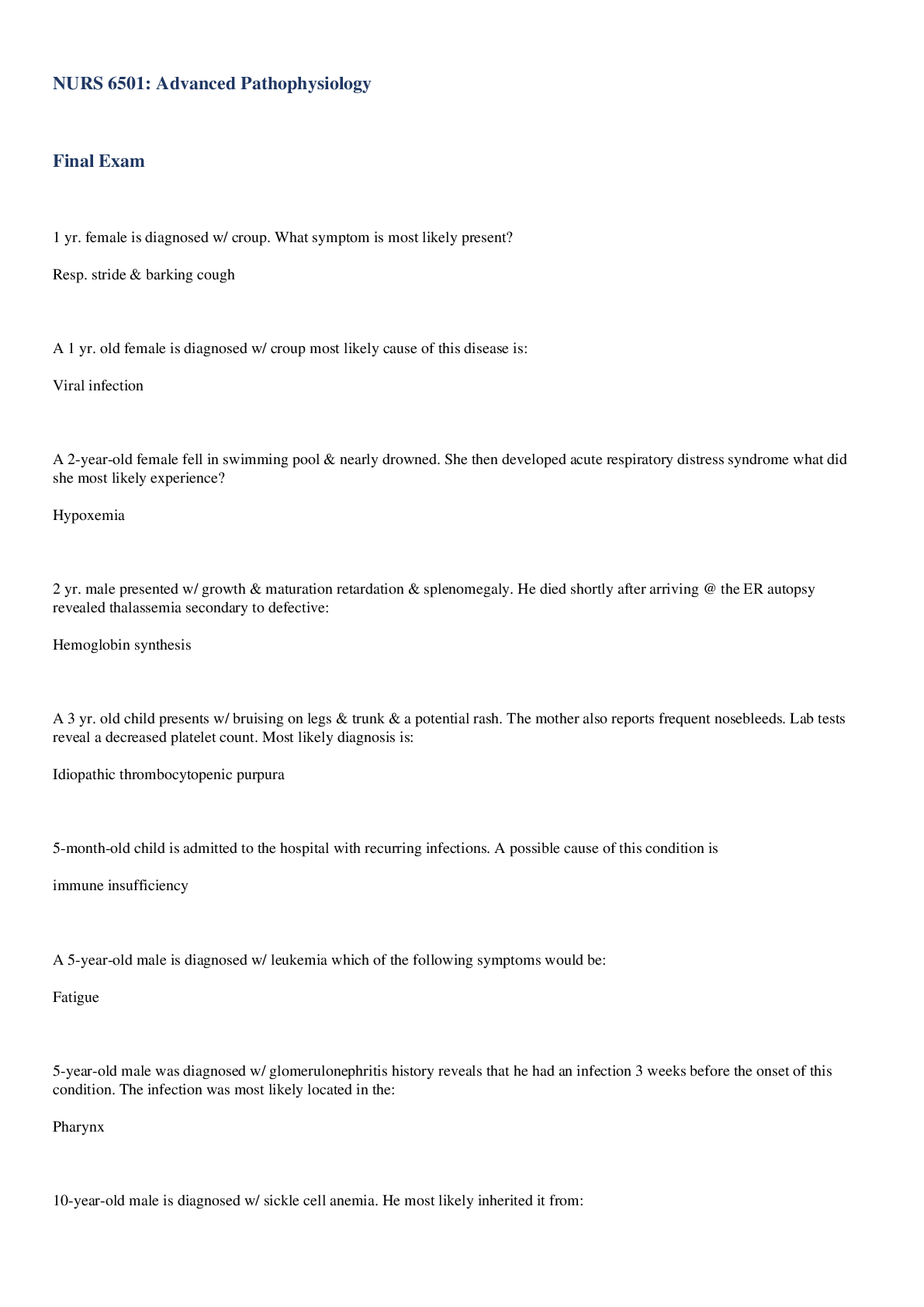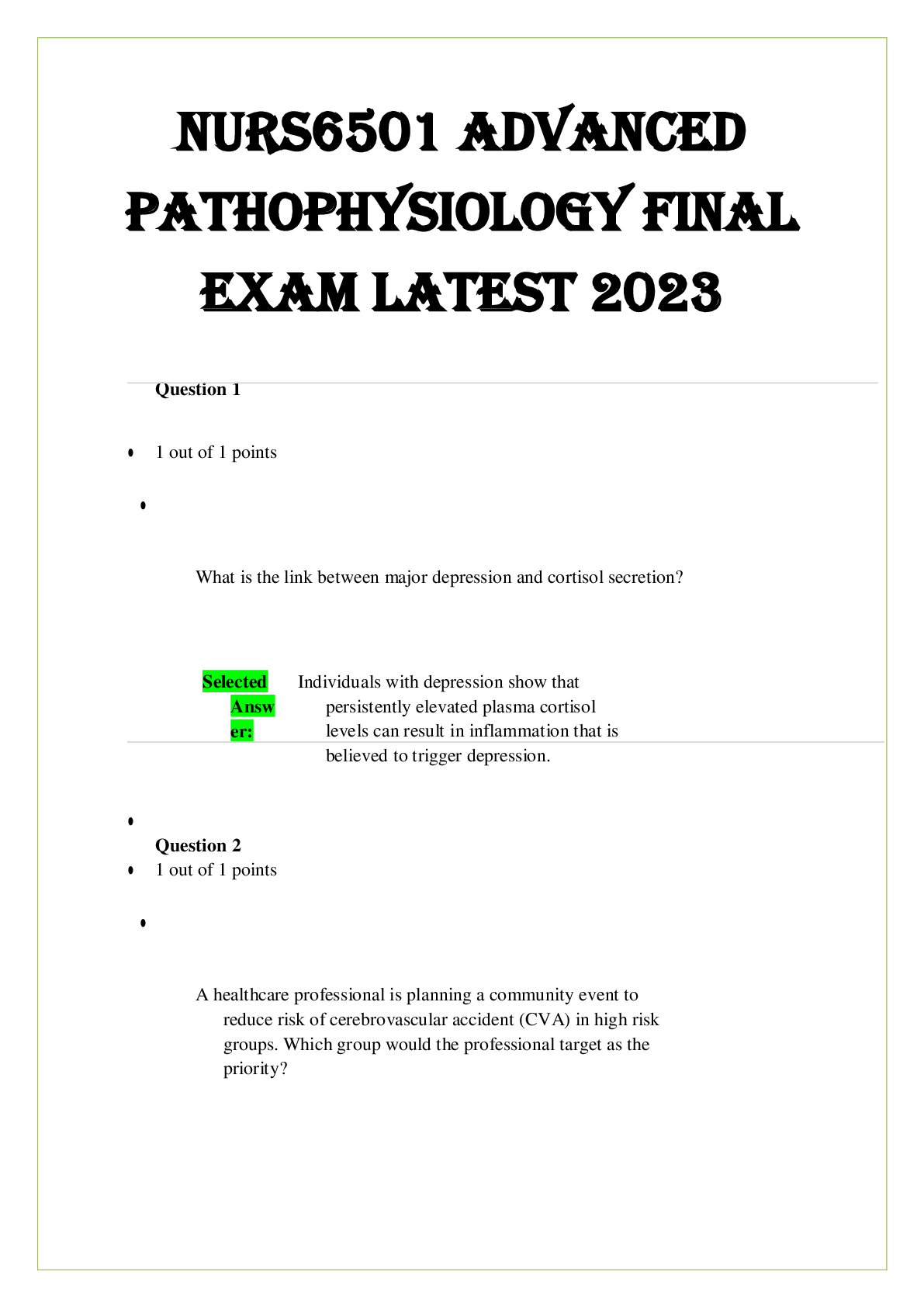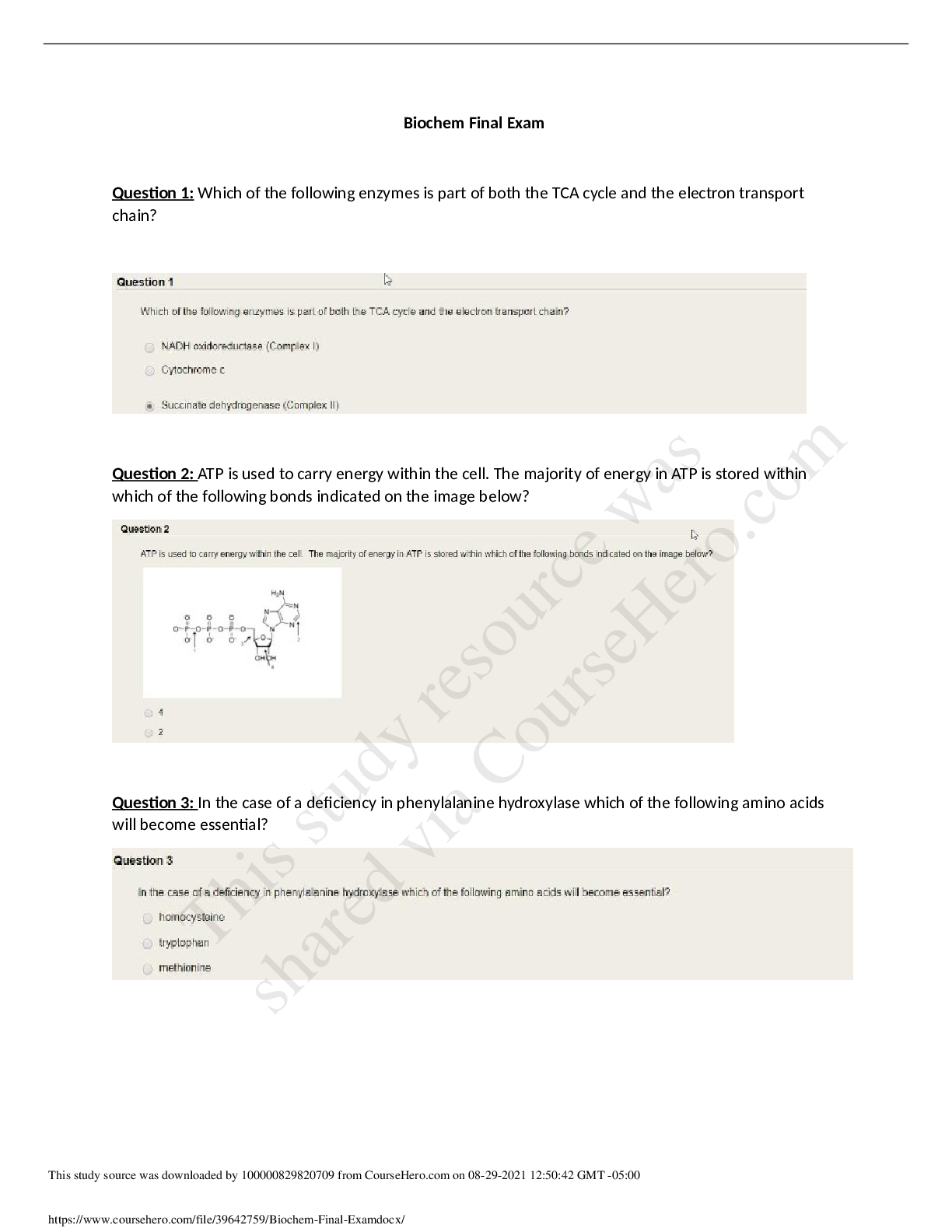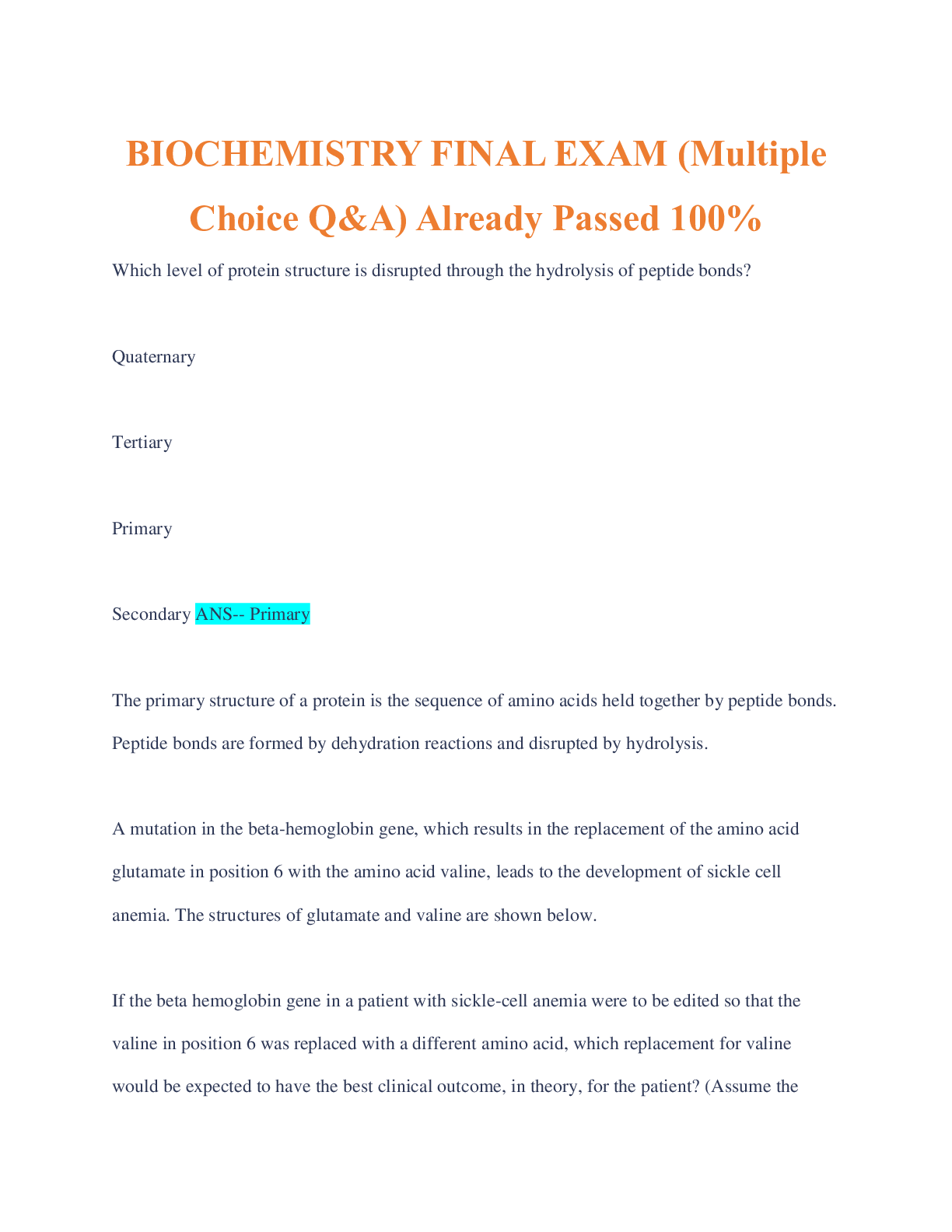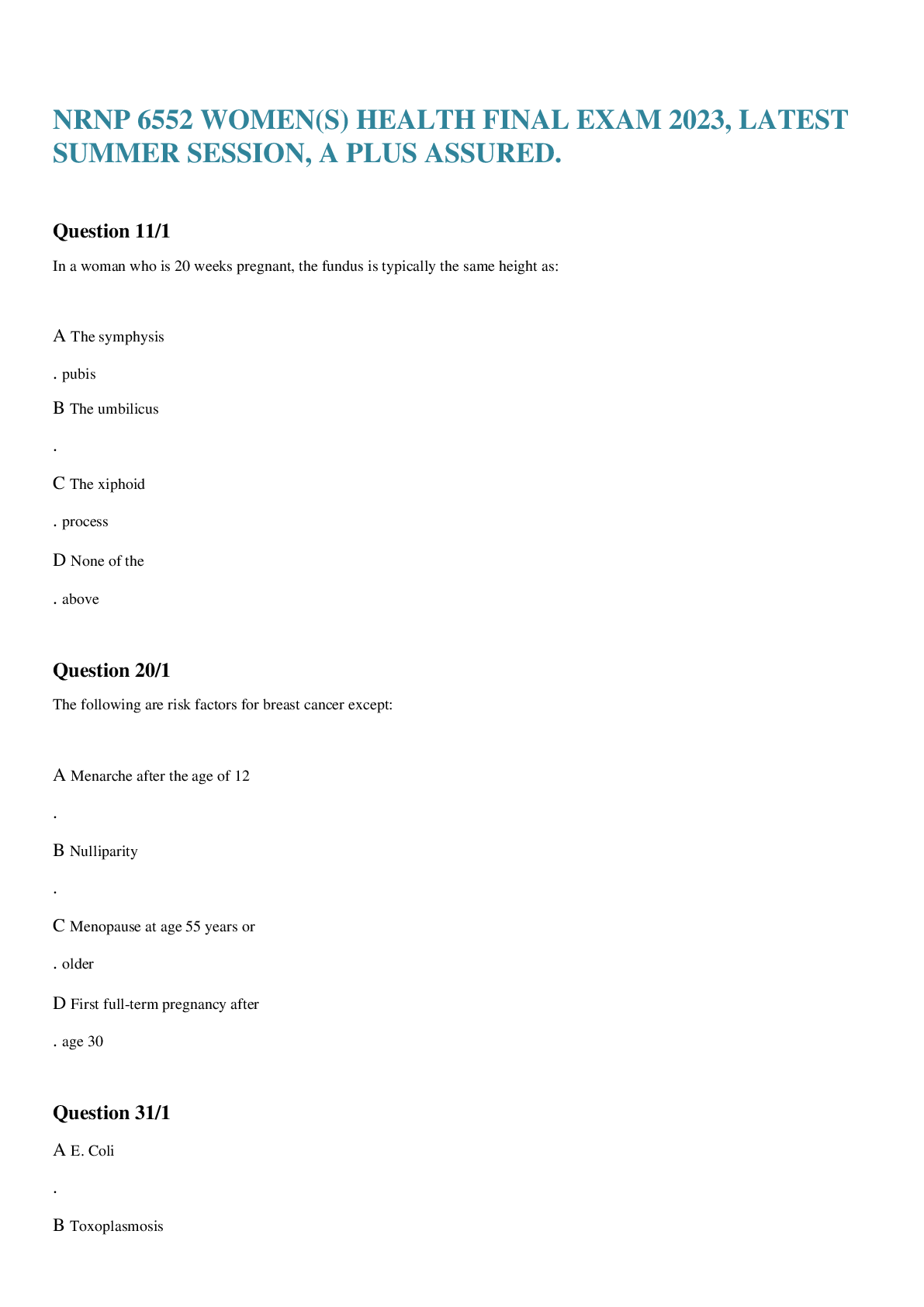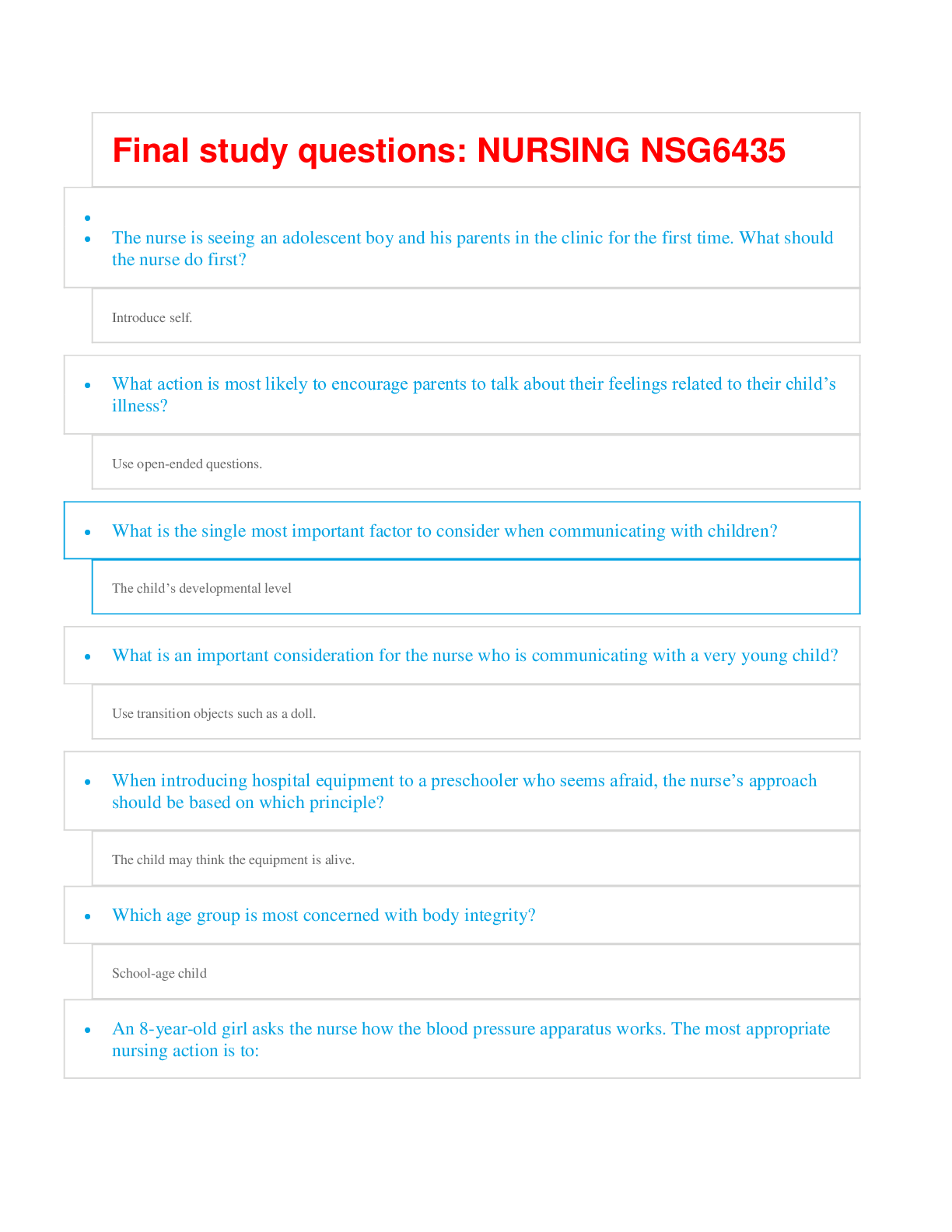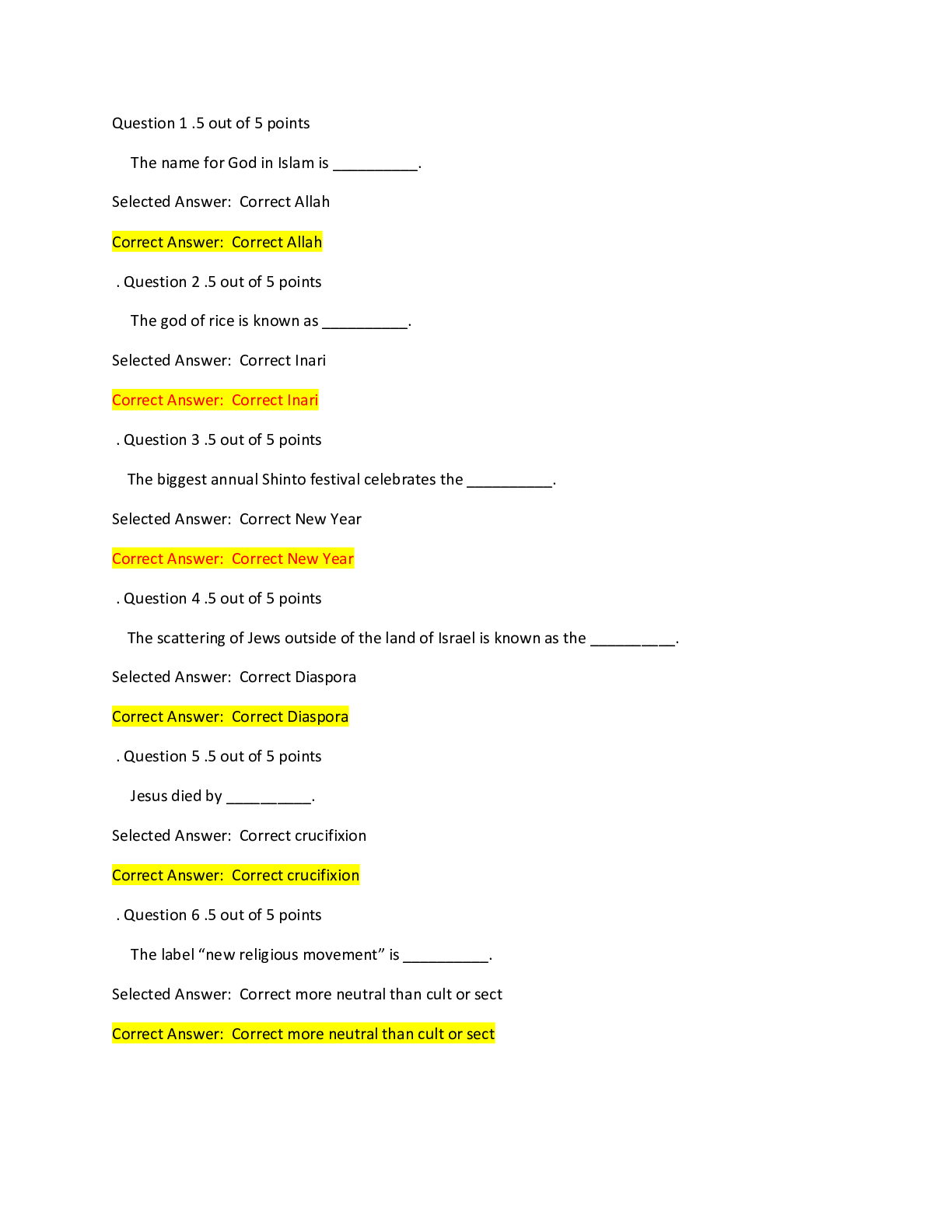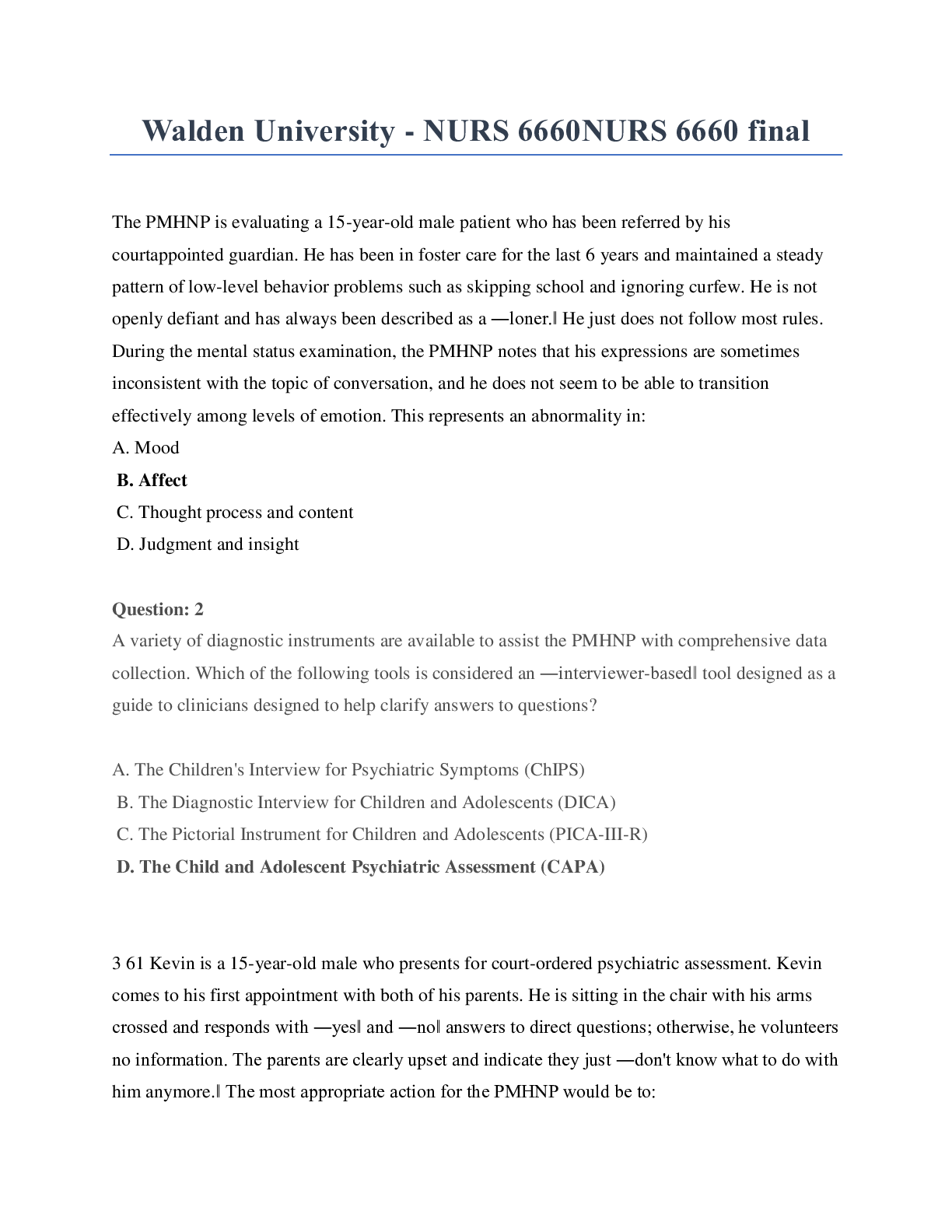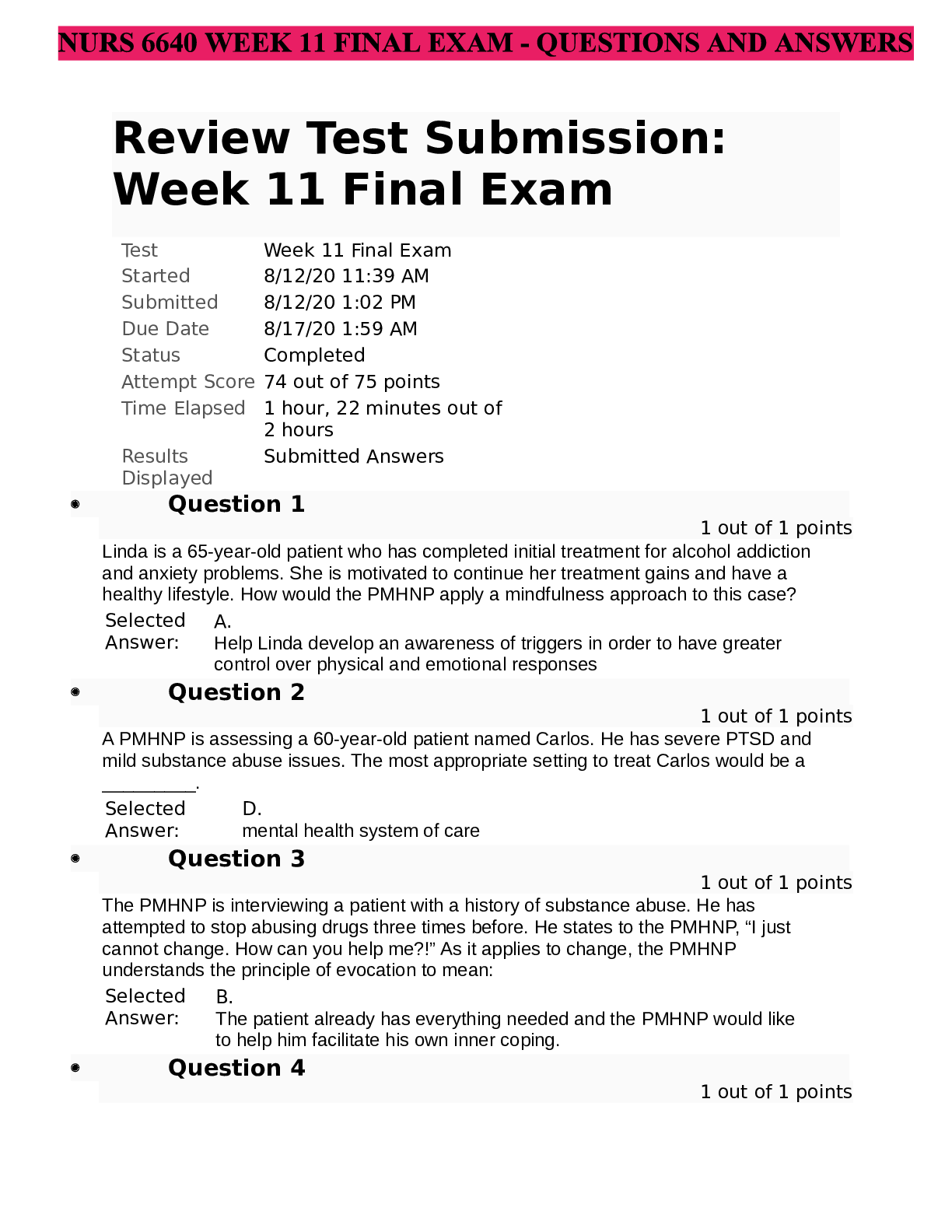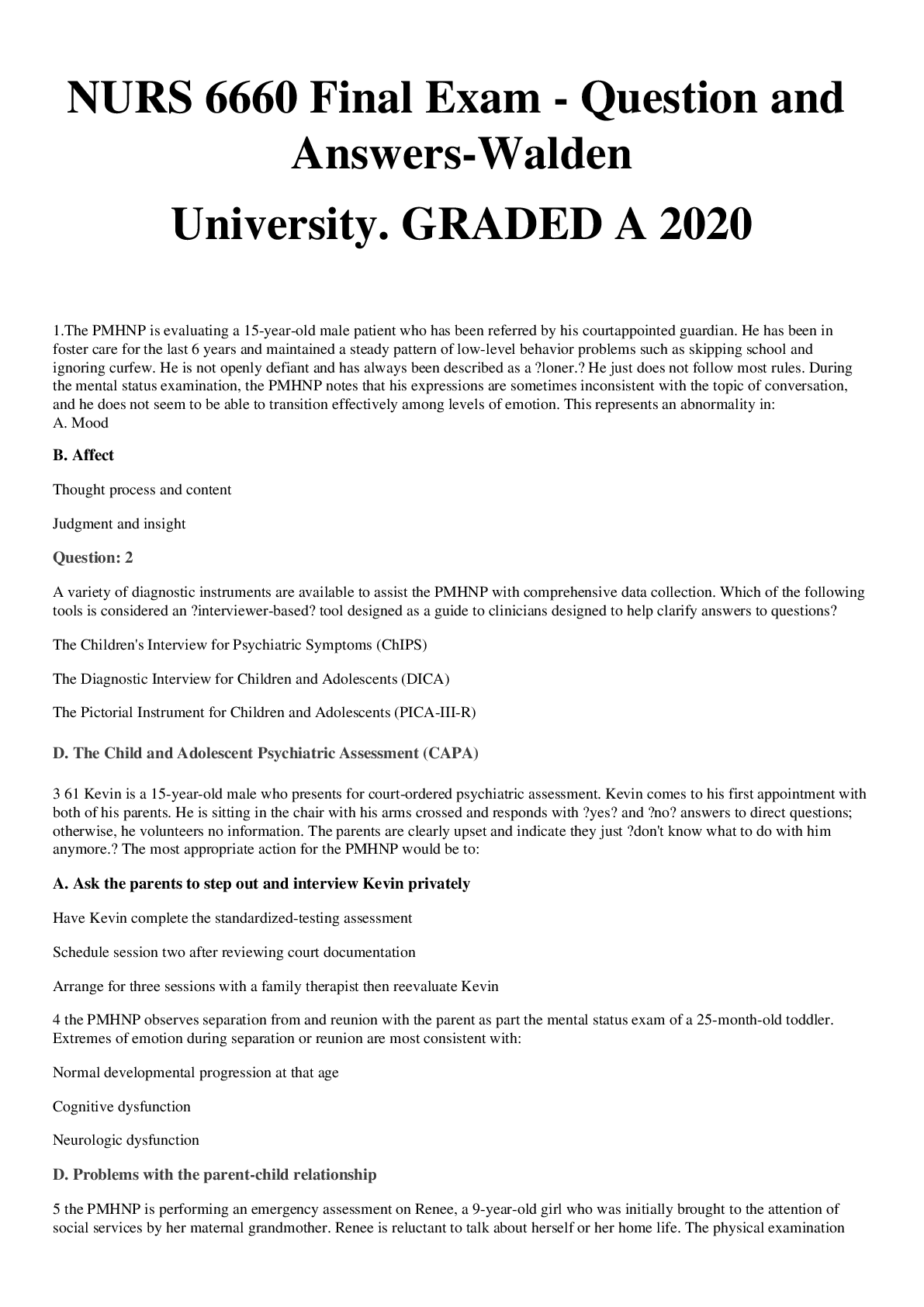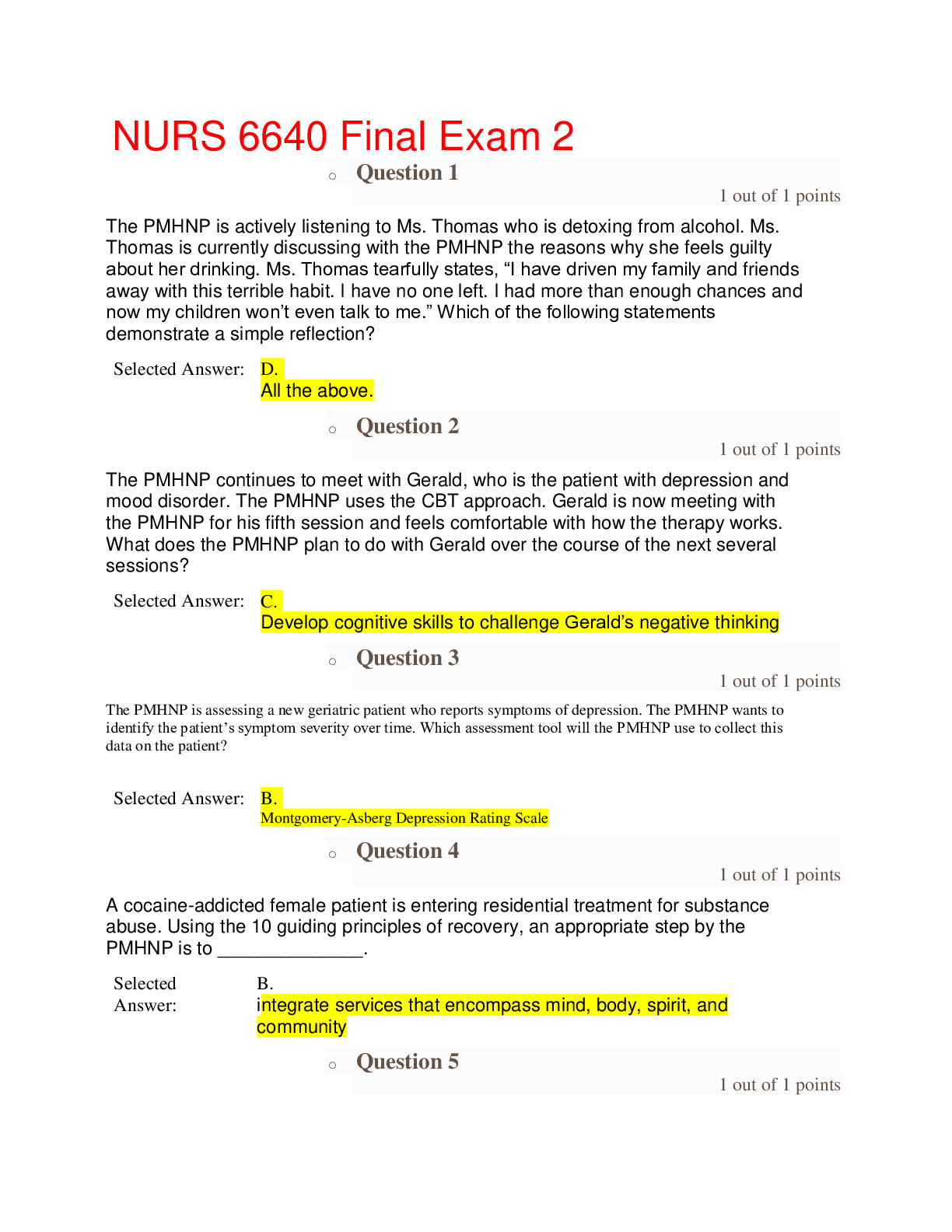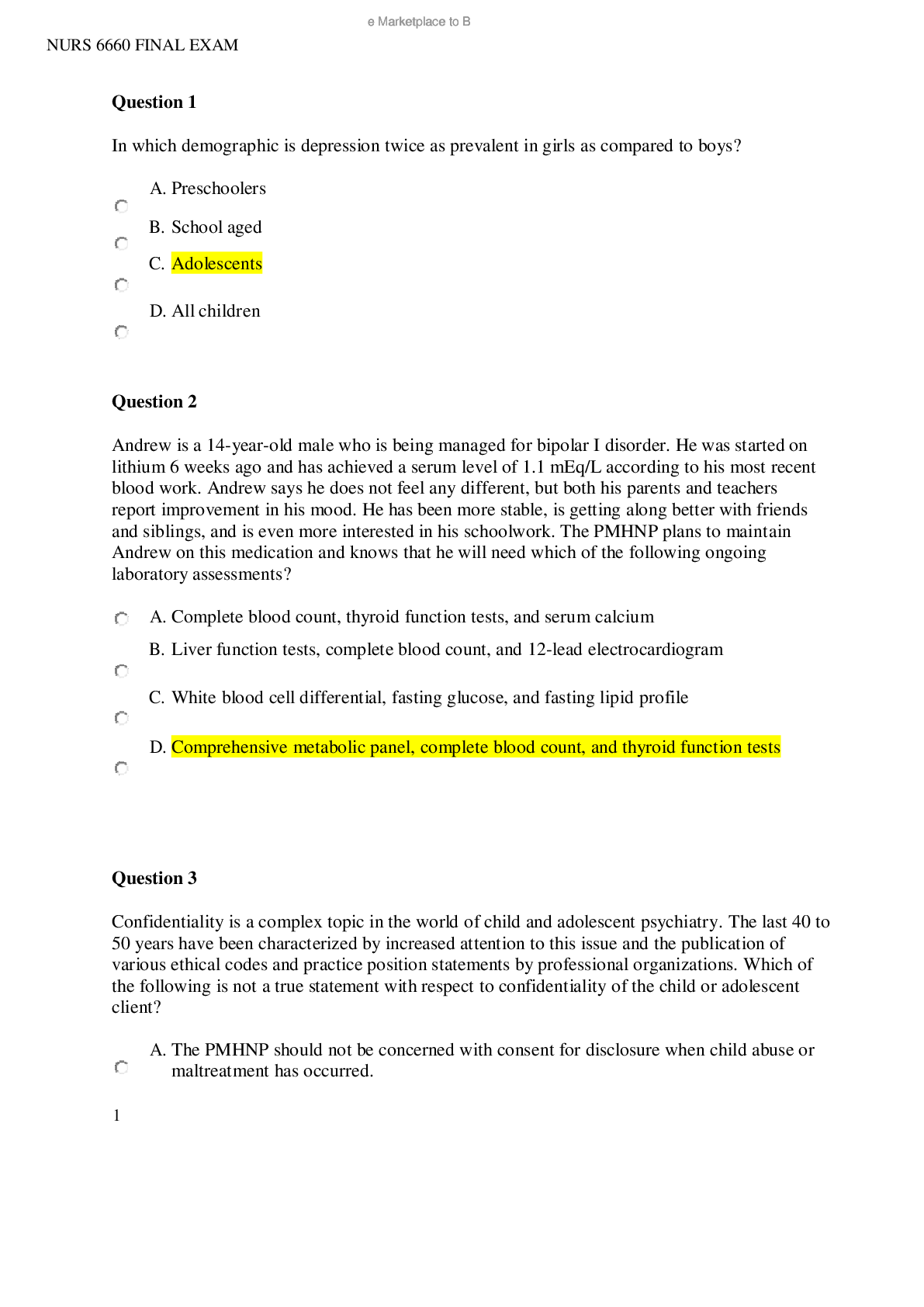*NURSING > FINAL EXAM > NURS 6501 Advanced Pathophysiology Final Exam 2 / NURS6501 Exam (Latest): Walden University (Already (All)
NURS 6501 Advanced Pathophysiology Final Exam 2 / NURS6501 Exam (Latest): Walden University (Already graded A)
Document Content and Description Below
NURS 6501: Advanced Pathophysiology Final Exam 1. The student is studying for a pathophysiology exam and is trying to remember the definition of amphipathic. The student should choose whic... h of the following to be correct? a. All cells have a membrane that is composed of lipids. b. Cells have organelles that have specialized function. c. Molecules are polar with one-part loving water and one part hating water. d. Cells have receptor sites that other substances attach to and create additional functions. 2. A nurse is reviewing the pedigree chart. When checking for a proband, what is the nurse looking for? a. The person who is first diagnosed with a genetic disease b. The individual who has a disease gene but is phenotypically normal c. The phenotype of genetic material d. The codominance 3. A nurse is reviewing a report from a patient with metastatic cancer. What finding would support the diagnosis of metastatic cancer? Alterations in extracellular matrix that include: a. Decreased fibronectin b. Increased collagen c. Decreased elastin d. Increased glycoproteins 4. An athlete runs a marathon, after which his muscles feel fatigued and unable to contract. The athlete asks the nurse why this happened. How should the nurse respond? A deficiency in ________ can cause impaired muscle contraction. a. GTP b. AMP c. ATP d. GMP 5. A runner has depleted all the oxygen available for muscle energy. Which of the following will facilitate his continued muscle performance? a. Electron-transport chain b. Aerobic glycolysis c. Anaerobic glycolysis d. Oxidative phosphorylation 6. The faculty member asked the student to identify the appropriate term for the movement of small, electrically uncharged molecules through a semipermeable barrier. Which answer indicates the nursing student understood the teaching? a. Osmosis b. Diffusion c. Hydrostatic pressure d. Active transport 7. A nurse is teaching a patient about fluid and electrolytes. Which of the following indicates the teaching was successful regarding electrolytes? Electrolytes are: a. Small lipid-soluble molecules b. Large protein molecules c. Micronutrients used to produce ATP d. Electrically charged molecules 8. A DNA strand has a region with the sequence ATCGGAT. Which of the following would be a complementary strand? a. CGATACGT b. TAGCCTAG c. TUGCCTUG d. UAGCCUAG 9. The base components of DNA are: a. A, G, C, and U b. P, G, C, and T c. A, G, C, and T d. X, XX, XY, and YY 10. A nurse recalls the basic components of DNA are: a. Pentose sugars and four phosphate bases b. A phosphate molecule, deoxyribose, and four nitrogenous bases c. Adenine, guanine, and purine d. Codons, oxygen, and cytosine 11. Which of the following mutations have the most significant effect on protein synthesis? a. Base pair substitutions b. Silent mutations c. Intron mutations d. Frameshift mutations 12. A 5-year-old male presents with mental retardation and is diagnosed with fragile X syndrome. When the parents ask what caused this, how should the geneticist respond? This was most probably caused from: a. Translocation b. Inversion c. Nondisjunction d. Duplication at fragile sites 13. A 50-year-old male was recently diagnosed with Huntington disease. Transmission of this disease is associated with: a. Penetrance b. Recurrence risk c. Expressivity d. Delayed age of onset 14. Mutations that do not change the amino acid sequence and thus have no consequence are termed _____ mutations. a. Frameshift b. Spontaneous c. Silent d. Missense 15. Which of the following disorders is manifested primarily in males? a. Cystic fibrosis b. Neurofibromatosis c. Muscular dystrophy d. Klinefelter syndrome 16. When the nurse is teaching the staff about X-linked recessive disorders, which information should the nurse include? (Select all that apply.) a. The trait is seen much more often in females than in males. b. The trait is never transmitted from father to son. c. The gene can be transmitted through a series of carrier females. d. The gene is passed from an affected father to all his daughters. e. The trait never skips generations. 17. A 12-year-old male is diagnosed with Klinefelter syndrome. His karyotype would reveal which of the following? a. XY b. XX c. XYY d. XXY 18. To express a polygenic trait: a. Genes must interact with the environment. b. Several genes must act together. c. Multiple mutations must occur in the same family. d. Penetrance must occur. 19. What is the diagnosis of a 13-year-old female who has a karyotype that reveals an absent homologous X chromosome with only a single X chromosome present? Her features include a short stature, widely spaced nipples, reduced carrying angle at the elbow, and sparse body hair. a. Down syndrome b. Cri du chat syndrome c. Turner syndrome d. Klinefelter syndrome 20. A normal male and a female carrier for red-green color blindness mate. Given that red-green color blindness is an X-linked recessive trait, what is the likelihood of their children being affected? a. 25% b. 50% c. Females most affected; no males affected d. Males most affected; no females affected 21. The gradual increase in height among the human population over the past 100 years is an example of: a. A polygenic trait b. A multifactorial trait c. Crossing over d. Recombination 22. When discussing DNA replication, which enzyme is most important? a. RNA polymerase b. Transfer RNA c. Messenger RNA d. DNA polymerase 23. The regions of the heterogeneous nuclear RNA that must be spliced out to form functional RNA are called: a. Promoter sites b. Introns c. Exons d. Anticodon 24. A couple has three offspring: one child with an autosomal dominant disease trait and two who are normal. The father is affected by the autosomal dominant disease, but the mother does not have the disease gene. What is the recurrence risk of this autosomal dominant disease for their next child? a. 50% b. 33% c. 25% d. Impossible to determine 25. An aide asks the nurse why people who have neurofibromatosis will show varying degrees of the disease. Which genetic principle should the nurse explain to the aide? a. Penetrance b. Expressivity c. Dominance d. Recessiveness 26. When a patient asks what causes cystic fibrosis, how should the nurse respond? Cystic fibrosis is caused by an _____ gene. a. X-linked dominant b. X-linked recessive c. Autosomal dominant d. Autosomal recessive 27. A 15-year-old female is diagnosed with Prader-Willi syndrome. This condition is an example of: a. Gene imprinting b. An autosomal recessive trait c. An autosomal dominant trait d. A sex-linked trait 28. A patient, age 9, is admitted to a pediatric unit with Duchenne muscular dystrophy. When planning care, the nurse recalls the patient inherited this condition through a _____ trait. a. Sex-linked dominant b. Sex-influenced c. Sex-limited d. Sex-linked recessive 29. A child is born with blue eyes (bb). The child's mother has blue eyes and the father has brown eyes. Which of the following represents the father? a. bB b. Bb c. BB d. Bbb 30. A patient has severe mental retardation caused by a deletion of part of chromosome 5. What genetic disorder will the nurse see documented in the chart? a. Prader-Willi syndrome b. Down syndrome c. Cri du chat syndrome d. Trisomy X 31. A child is diagnosed with cystic fibrosis. History reveals that the child's parents are siblings. Cystic fibrosis was most likely the result of: a. X inactivation b. Genomic imprinting c. Consanguinity d. Obligate carriers 32. A biologist is explaining how RNA directs the synthesis of protein. Which process is the biologist describing? a. Termination b. Transcription c. Translocation d. Translation 33. When homologous chromosomes fail to separate during meiosis, which of the following occurs? a. Neurofibromatosis b. Nondisjunction c. Polyploidy d. Conjoined twins 34. A cell that does not contain a multiple of 23 chromosomes is called a _____ cell. a. diploid b. euploid c. polyploid d. haploid 35. A 20-year-old pregnant female gives birth to a stillborn child. Autopsy reveals that the fetus has 92 chromosomes. What term may be on the autopsy report to describe this condition? a. Biploidy b. Triploidy c. Tetraploidy d. Aneuploidy 36. The condition in which an extra portion of a chromosome is present in each cell is called: a. Reciprocal translocation b. Partial trisomy c. Inversion d. Down syndrome 37. After a geneticist talks to the patient about being a chromosomal mosaic, the patient asks the nurse what that means. How should the nurse respond? You may _____ genetic disease(s). a. Only be a carrier of the b. Have a mild form of the c. Have two d. Be sterile as a result of the 38. The nurse is teaching staff about the most common cause of Down syndrome. What is the nurse describing? a. Paternal nondisjunction b. Maternal translocations c. Maternal nondisjunction d. Paternal translocations 39. A patient wants to know the risk factors for Down syndrome. What is the nurse's best response? a. Fetal exposure to mutagens in the uterus b. Increased paternal age c. Family history of Down syndrome d. Pregnancy in women over age 35 40. A 13-year-old girl has a karyotype that reveals an absent homologous X chromosome with only a single X chromosome present. What medical diagnosis will the nurse observe on the chart? a. Down syndrome b. Cri du chat syndrome c. Turner syndrome d. Fragile X syndrome 41. An XXY person asks the nurse what this genetic disorder is called. What is the nurse's best response? This disorder is _____ syndrome. a. Turner b. Klinefelter c. Down d. Fragile X 42. A student is observing a cell under the microscope. It is observed to have supercoiled DNA with histones. Which of the following would also be observed by the student? a. A single circular chromosome b. A nucleus c. Free-floating nuclear material d. No organelles 43. A nurse is instructing the staff about cellular functions. Which cellular function is the nurse describing when an isolated cell absorbs oxygen and uses it to transform nutrients to energy? a. Metabolic absorption b. Communication c. Secretion d. Respiration 44. A eukaryotic cell is undergoing DNA replication. In which region of the cell would most of the genetic information be contained? a. Mitochondria b. Ribosome c. Nucleolus d. Nucleus 45. The fluid mosaic model for biologic membranes describes membrane behavior. According to this model, which of the following float singly or as aggregates in the fluid lipid bilayer? a. Peripheral membrane proteins b. Integral membrane proteins c. Glycoproteins d. Cell adhesion molecules 46. Which of the following can bind to plasma membrane receptors? a. Oxygen b. Ribosomes c. Amphipathic lipids d. Ligands 47. Which form of cell communication is used to relate to other cells in direct physical contact? a. Cell junction b. Gap junction c. Desmosomes d. Tight junctions 48. Pancreatic beta cells secrete insulin, which inhibits secretion of glucagon from neighboring alpha cells. This action is an example of which of the following signaling types? a. Paracrine b. Autocrine c. Neurohormonal d. Hormonal 49. In cellular metabolism, each enzyme has a high affinity for a: a. Solute b. Substrate c. Receptor d. Ribosome 50. Which phase of catabolism produces the most ATP? a. Digestion b. Glycolysis c. Oxidation d. Citric acid cycle 51. A nurse is teaching the staff about the three phases of cellular catabolism. Which of the following should the nurse include? a. Digestion, glycolysis and oxidation, and the citric acid cycle b. Diffusion, osmosis, and mediated transport c. S phase, G phase, and M phase d. Metabolic absorption, respiration, and excretion 52. A nurse is reading a chart and sees the term oncotic pressure. The nurse recalls that oncotic pressure (colloid osmotic pressure) is determined by: a. Concentration of sodium b. Plasma proteins c. Hydrostatic pressure d. Availability of membrane transporter proteins 53. A patient has a body fluid of 300 mOsm/kg. This lab result is measuring: a. Osmolality b. Osmolarity c. Osmotic pressure d. Oncotic pressure 54. In teaching a patient with cirrhosis, which information should the nurse include regarding cholesterol? a. Cholesterol decreases the membrane fluidity of the erythrocyte, which reduces its ability to carry oxygen. b. Cholesterol decreases the membrane fluidity of erythrocytes, which reduces its ability to carry hemoglobin. c. Cholesterol increases the membrane fluidity of erythrocytes, which allows binding of excess glucose. d. Cholesterol increases the membrane fluidity of erythrocytes, which prolongs its life span beyond 120 days 55. A nurse is discussing the movement of fluid across the arterial end of capillary membranes into the interstitial fluid surrounding the capillary. Which process of fluid movement is the nurse describing? a. Hydrostatic pressure b. Osmosis c. Diffusion d. Active transport 56. A patient who has diarrhea receives a hypertonic saline solution intravenously to replace the sodium and chloride lost in the stool. What effect will this fluid replacement have on cells? a. Cells will become hydrated. b. Cells will swell or burst. c. Cells will shrink. d. Cells will divide. 57. A nurse is teaching a patient with diabetes how glucose is transported from the blood to the cell. What type of transport system should the nurse discuss with the patient? a. Active-mediated transport (active transport) b. Active diffusion c. Passive osmosis d. Passive-mediated transport (facilitated diffusion) 58. How are potassium and sodium transported across plasma membranes? a. By passive electrolyte channels b. By coupled channels c. By adenosine triphosphate enzyme (ATPase) d. By diffusion 59. Why is potassium able to diffuse easily in and out of cells? a. Because potassium has a greater concentration in the intracellular fluid (ICF) b. Because sodium has a greater concentration in the extracellular fluid (ECF) c. Because the resting plasma membrane is more permeable to potassium d. Because there is an excess of anions inside the cell 60. The ion transporter that moves Na+ and Ca2+ simultaneously in the same direction is an example of which of the following types of transport? a. Biport b. Uniport c. Antiport d. Symport 61. During which process can lysosomal enzymes be released to degrade engulfed particles? a. Endocytosis b. Pinocytosis c. Phagocytosis d. Exocytosis 62. A nurse is teaching the staff about cholesterol. Which information should be taught? The cellular uptake of cholesterol depends on: a. Active-mediated transport b. The antiport system c. Receptor-mediated endocytosis d. Passive transport 63. Some cancer drugs work during the cell cycle phase where nuclear and cytoplasmic division occurs. What is this cell cycle phase called? a. G1 b. S c. M d. G2 64. What causes the rapid change in the resting membrane potential that initiates an action potential? a. Potassium gates open, and potassium rushes into the cell, changing the membrane potential from negative to positive. b. Sodium gates open, and sodium rushes into the cell, changing the membrane potential from negative to positive. c. Sodium gates close, allowing potassium into the cell to change the membrane potential from positive to negative. d. Potassium gates close, allowing sodium into the cell to change the membrane potential from positive to negative. 65. A cell is isolated, and electrophysiology studies reveal that the resting membrane potential is -70 millivolts. The predominant intracellular ion is Na+, and the predominant extracellular ion is K+. With voltage change, which of the following would result in an action potential? a. K+ rushing into the cell b. Na+ rushing into the cell c. Na+ rushing out of the cell d. K+ rushing out of the cell 66. A nurse is teaching the staff about platelet-derived growth factor. Which information should the nurse include? Platelet-derived growth factor (PDGF) stimulates the production of: a. Platelets b. Epidermal cells c. Connective tissue cells d. Fibroblast cells 67. The phase of the cell cycle during which the centromeres split and the sister chromatids are pulled apart is referred to as: a. Anaphase b. Telophase c. Prophase d. Metaphase 68. What is the role of cytokines in cell reproduction? a. Provide growth factor for tissue growth and development b. Block progress of cell reproduction through the cell cycle c. Restrain cell growth and development d. Provide nutrients for cell growth and development 69. A biopsy of the lung bronchi revealed ciliated epithelial cells that are capable of secretion and absorption. These cells are called _____ columnar epithelium. a. Simple b. Ciliated simple c. Stratified d. Pseudostratified ciliated 70. The nurse would be correct in identifying the predominant extracellular cation as: a. Sodium b. Potassium c. Chloride d. Glucose 71. The student is reviewing functions of the cell. The student would be correct in identifying the primary function of the nerve cell as: a. Sensory interpretation b. Conductivity c. Maintenance of homeostasis d. Communication 72. A nurse recalls that the four basic types of tissues are (select all that apply): a. Nerve b. Epithelial c. Mucosal d. Connective e. Skeletal f. Muscle 73. Characteristics of prokaryotes include which of the following? (Select all that apply.) a. They contain no organelles. b. Their nuclear material is not encased by a nuclear membrane. c. They contain a distinct nucleus. d. They contain histones. e. They contain a cellular membrane. [Show More]
Last updated: 8 months ago
Preview 1 out of 17 pages
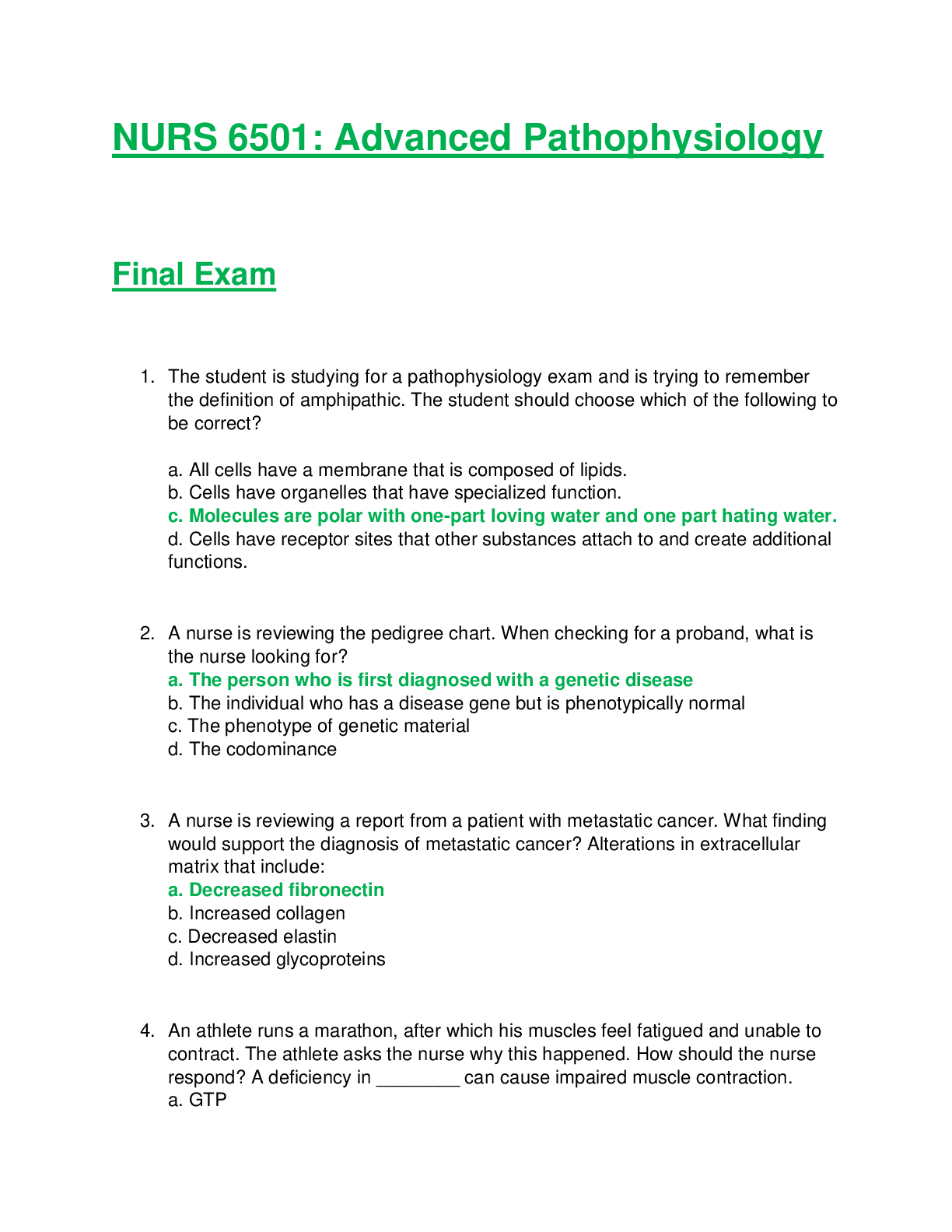
Reviews( 0 )
Document information
Connected school, study & course
About the document
Uploaded On
Oct 28, 2020
Number of pages
17
Written in
Additional information
This document has been written for:
Uploaded
Oct 28, 2020
Downloads
3
Views
249

